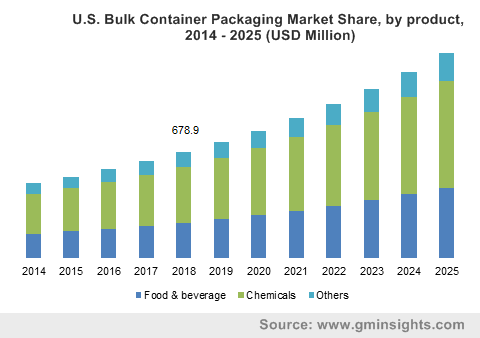Mounting demand for secure food and beverage transportation to fuel bulk container packaging market over 2019-2025
Publisher : Fractovia | Latest Update: 2019-08-06 | Published Date : 2017-02-17Request Sample
Bulk container packaging market growth is being propelled by flourishing food and beverage industry as well as rising demand for secure transportation of food and beverages. Bulk containers are exerting wide-ranging impact across diverse industries as they reduce cost and increase efficiencies in material handling and transportation.
Bulk containers offer unique benefits, such as reusability, recyclability, durability, resistance to moisture, lightweight, etc.. Aided by these features, bulk containers are in high demand for packaging in food & beverage and healthcare industry. Growing trade in food industry along with expansion of healthcare sector will majorly influence the use of bulk containers for packaging and transportation, and hence drive the bulk container packaging market.
U.S. Bulk Container Packaging Market Share, by product, 2014 - 2025 (USD Million)

Intermediate bulk containers segment has gained significant traction in bulk container packaging market, due to capabilities of efficient product handling of sensitive/dangerous goods. Intermediate bulk containers are closed shipping vessels, having a liquid storage capacity from 450-3,000 liters. Intermediate bulk containers are used for storing and shipping liquids that are flammable or combustible and are listed under UN’s Recommendations on the Transport of Dangerous Goods and Code of Federal Regulations.
Without a secure packaging option, transportation of hazardous goods, such as flammable liquids (petrol, diesel, kerosene, etc.), explosives, chemicals and radioactive materials is not possible. Intermediate bulk containers provide a safe and secure transportation means for shipping hazardous goods. Intermediate bulk containers increase efficiency in transportation, goods handling, warehousing and reduce costs.
Intermediate bulk containers hold an equivalent of multiple drums, which results in better utilization of cube during storage and transportation. It is a much safer option due to fewer encounters between personnel and containers. Intermediate bulk containers are made using the blow molding process instead of drilling which results in the reduction of contamination probabilities.
Growing demands for safer and cheaper shipping are expanding intermediate bulk containers market, which is further estimated to bring substantial proceeds to the overall bulk container packaging market during the forecast period.
Bulk container packaging is used across various industry verticals; however, it is dominantly used by food industry. Bakeries, dairy, poultry, general food processors and suppliers are increasingly opting for bulk container packaging system to drive sustainability, reduce costs and optimizing supply chains.
Bulk containers are best for transporting and storing liquid as well as dry products and are an ideal replacement for plastic containers and corrugated boxes. Contoured design for easy handling, ease of cleanability and non-porous surfaces make bulk containers packaging ideal for food and beverage application. Their rigid walls offer resistance to sagging during storage and distribution.
Due to promising product use in food industry, the bulk container packaging industry size is anticipated to be positively impacted. Changes in living standards, owing to rapid industrialization in emerging economies has triggered demand for packaged food in recent years. Shifting consumer preference for packaged, ready-to-eat foods is majorly driving food and beverage packaging industry, which is projected to add impetus to bulk container packaging market trends over 2019-2025.
In 2018, Asia Pacific and North America accounted for the largest share in bulk container packaging market. China is witnessing tremendous growth in the food and beverage industry due to rapidly growing urban population which in turn has been complementing the expansion of bulk container packaging market size.
As per National Bureau of Statistics of China, the country’s per capita disposable income was USD 4,033 in 2017, increasing by 7.3% year-on-year in real terms. Rapid globalization, rising disposable incomes and growing food and beverage import-export trades in China is projected to expand the bulk container packaging market outlook over the forecast timeline.
Suitability of bulk containers for transportation of goods across various industry verticals is projected to consolidate the overall bulk container market share over the forecast timespan.